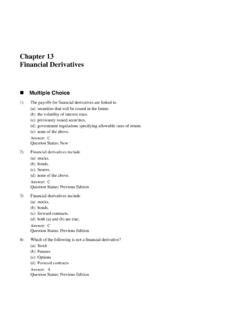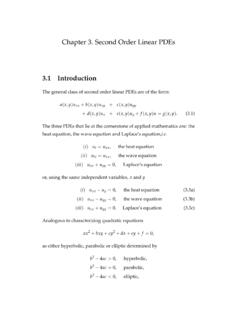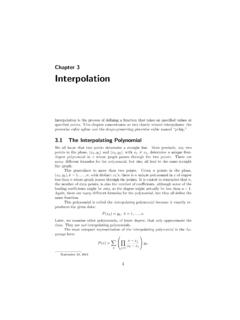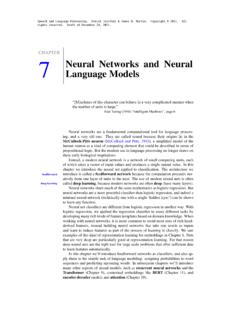Transcription of LIMITS AND DERIV ATIVES - NCERT
1 V Statistics may be rightly called the science of averages and theirestimates. & BODDINGTON IntroductionWe know that statistics deals with data collected for specificpurposes. We can make decisions about the data byanalysing and interpreting it. In earlier classes, we havestudied methods of representing data graphically and intabular form. This representation reveals certain salientfeatures or characteristics of the data. We have also studiedthe methods of finding a representative value for the givendata. This value is called the measure of central mean (arithmetic mean), median and mode are threemeasures of central tendency. A measure of centraltendency gives us a rough idea where data points arecentred. But, in order to make better interpretation from thedata, we should also have an idea how the data are scattered or how much they arebunched around a measure of central now the runs scored by two batsmen in their last ten matches as follows:Batsman A : 30, 91, 0, 64, 42, 80, 30, 5, 117, 71 Batsman B.
2 53, 46, 48, 50, 53, 53, 58, 60, 57, 52 Clearly, the mean and median of the data areBatsman ABatsman BMean5353 Median5353 Recall that, we calculate the mean of a data (denoted by x) by dividing the sumof the observations by the number of observations, ,13 ChapterSTATISTICSKarl Pearson (1857-1936)Rationalised 2023-24258 MATHEMATICS11niixxn== Also, the median is obtained by first arranging the data in ascending or descendingorder and applying the following the number of observations is odd, then the median is th12n+ the number of observations is even, then median is the mean of th2n andth12n + find that the mean and median of the runs scored by both the batsmen A andB are same , 53. Can we say that the performance of two players is same? ClearlyNo, because the variability in the scores of batsman A is from 0 (minimum) to 117(maximum). Whereas, the range of the runs scored by batsman B is from 46 to us now plot the above scores as dots on a number line.
3 We find the followingdiagrams:For batsman AFor batsman BWe can see that the dots corresponding to batsman B are close to each other andare clustering around the measure of central tendency (mean and median), while thosecorresponding to batsman A are scattered or more spread , the measures of central tendency are not sufficient to give completeinformation about a given data. Variability is another factor which is required to bestudied under statistics. Like measures of central tendency we want to have asingle number to describe variability. This single number is called a measure ofdispersion . In this Chapter, we shall learn some of the important measures of dispersionand their methods of calculation for ungrouped and grouped 2023-24 STATISTICS Measures of DispersionThe dispersion or scatter in a data is measured on the basis of the observations and thetypes of the measure of central tendency, used there. There are following measures ofdispersion:(i) Range, (ii) Quartile deviation, (iii) Mean deviation, (iv) Standard this Chapter, we shall study all of these measures of dispersion except thequartile that, in the example of runs scored by two batsmen A and B, we had some ideaof variability in the scores on the basis of minimum and maximum runs in each obtain a single number for this, we find the difference of maximum and minimumvalues of each series.
4 This difference is called the Range of the case of batsman A, Range = 117 0 = 117 and for batsman B, Range = 60 46 = , Range of A > Range of B. Therefore, the scores are scattered or dispersed incase of A while for B these are close to each , Range of a series = Maximum value Minimum range of data gives us a rough idea of variability or scatter but does not tellabout the dispersion of the data from a measure of central tendency. For this purpose,we need some other measure of variability. Clearly, such measure must depend uponthe difference (or deviation) of the values from the central important measures of dispersion, which depend upon the deviations of theobservations from a central tendency are mean deviation and standard deviation. Letus discuss them in DeviationRecall that the deviation of an observation x from a fixed value a is the differencex a. In order to find the dispersion of values of x from a central value a , we find thedeviations about a.
5 An absolute measure of dispersion is the mean of these find the mean, we must obtain the sum of the deviations. But, we know that ameasure of central tendency lies between the maximum and the minimum values ofthe set of observations. Therefore, some of the deviations will be negative and somepositive. Thus, the sum of deviations may vanish. Moreover, the sum of the deviationsfrom mean (x) is of deviations Sum of deviations00 Number of observationsn== =Thus, finding the mean of deviations about mean is not of any use for us, as faras the measure of dispersion is 2023-24260 MATHEMATICSR emember that, in finding a suitable measure of dispersion, we require the distanceof each value from a central tendency or a fixed number a . Recall, that the absolutevalue of the difference of two numbers gives the distance between the numbers whenrepresented on a number line. Thus, to find the measure of dispersion from a fixednumber a we may take the mean of the absolute values of the deviations from thecentral value.
6 This mean is called the mean deviation . Thus mean deviation about acentral value a is the mean of the absolute values of the deviations of the observationsfrom a . The mean deviation from a is denoted as (a). Therefore, (a) = Sum of absolute values of deviations from ' 'Number of Mean deviation may be obtained from any measure of central , mean deviation from mean and median are commonly used in us now learn how to calculate mean deviation about mean and mean deviationabout median for various types of Mean deviation for ungrouped data Let n observations be x1, x2, x3, .., following steps are involved in the calculation of mean deviation about mean ormedian:Step 1 Calculate the measure of central tendency about which we are to find the meandeviation. Let it be a .Step 2 Find the deviation of each xi from a, , x1 a, x2 a, x3 a,.. , xn aStep 3 Find the absolute values of the deviations, , drop the minus sign ( ), if it isthere, ,axaxaxaxn.
7 ,,,,321 Step 4 Find the mean of the absolute values of the deviations. This mean is the meandeviation about a, ,1( ) = ( x) =11niixxn= , where x= (M) =11 Mniixn= , where M = MedianRationalised 2023-24 STATISTICS 261 ANote In this Chapter, we shall use the symbol M to denote median unless us now illustrate the steps of the above method in following 1 Find the mean deviation about the mean for the following data:6, 7, 10, 12, 13, 4, 8, 12 Solution We proceed step-wise and get the following:Step 1 Mean of the given data is6 7 10 12 13 4 8 12 72988x+ + + + + + +== =Step 2 The deviations of the respective observations from the mean ,x , xi xare6 9, 7 9, 10 9, 12 9, 13 9, 4 9, 8 9, 12 9,or 3, 2, 1, 3, 4, 5, 1, 3 Step 3 The absolute values of the deviations, , ixx are 3, 2, 1, 3, 4, 5, 1, 3 Step 4 The required mean deviation about the mean ()x =818iixx= =3 2 1 3 4 5 1 3 222 7588.+ + + + + + += =ANote Instead of carrying out the steps every time, we can carry on calculation,step-wise without referring to 2 Find the mean deviation about the mean for the following data :12, 3, 18, 17, 4, 9, 17, 19, 20, 15, 8, 17, 2, 3, 16, 11, 3, 1, 0, 5 Solution We have to first find the mean (x) of the given data201120iixx== = 20200 = 10 Rationalised 2023-24262 MATHEMATICSThe respective absolute values of the deviations from mean, , xxi are2, 7, 8, 7, 6, 1, 7, 9, 10, 5, 2, 7, 8, 7, 6, 1, 7, 9, 10, 5 Therefore201124iixx= = (x) = 12420= 3 Find the mean deviation about the median for the following data:3, 9, 5, 3, 12, 10, 18, 4, 7, 19, Here the number of observations is 11 which is odd.
8 Arranging the data intoascending order, we have 3, 3, 4, 5, 7, 9, 10, 12, 18, 19, 21 NowMedian = th11 12+ or 6th observation = 9 The absolute values of the respective deviations from the median, , Mix are6, 6, 5, 4, 2, 0, 1, 3, 9, 10, 12 Therefore111M 58iix= = and( ) MM58 = = Mean deviation for grouped data We know that data can be grouped intotwo ways :(a) Discrete frequency distribution,(b) Continuous frequency us discuss the method of finding mean deviation for both types of the data.(a) Discrete frequency distribution Let the given data consist of n distinct valuesx1, x2, .., xn occurring with frequencies f1, f2 , .., fn respectively. This data can berepresented in the tabular form as given below, and is called discrete frequencydistribution:x : x1 x2x3 .. xnf : f1 f2f3 .. fnRationalised 2023-24 STATISTICS 263(i) Mean deviation about meanFirst of all we find the mean xof the given data by using the formula1111 Nni inii iniiix fxx ff===== ,where =niiifx1 denotes the sum of the products of observations xi with their respectivefrequencies fi and ==niif1N is the sum of the , we find the deviations of observations xi from the mean xand take theirabsolute values, , xxi for all i =1, 2.
9 , this, find the mean of the absolute values of the deviations, which is therequired mean deviation about the mean. ( )niiiniif xxxf== = = xxfinii =1N1(ii) Mean deviation about median To find mean deviation about median, we find themedian of the given discrete frequency distribution. For this the observations are arrangedin ascending order. After this the cumulative frequencies are obtained. Then, we identifythe observation whose cumulative frequency is equal to or just greater than N2, whereN is the sum of frequencies. This value of the observation lies in the middle of the data,therefore, it is the required median. After finding median, we obtain the mean of theabsolute values of the deviations from , (M)MNniiif x== Example 4 Find mean deviation about the mean for the following data :xi25681012fi28 107 8 5 Rationalised 2023-24264 MATHEMATICSS olution Let us make a Table of the given data and append other columns fixxi 9240N61== =iif, 30061= =iiixf, 9261= =xxfiiiTherefore6111300 iixf x=== = and6111M.
10 D. ( )92 = = Example 5 Find the mean deviation about the median for the following data:xi3691213152122fi34524543 Solution The given observations are already in ascending order. Adding a rowcorresponding to cumulative frequencies to the given data, we get (Table ).Table , N=30 which is 2023-24 STATISTICS 265 Median is the mean of the 15th and 16th observations. Both of these observationslie in the cumulative frequency 18, for which the corresponding observation is observation 16 observation 13 13 Therefore, Median M1322++===Now, absolute values of the deviations from median, , Mix are shown inTable 107410289fi34524543fiMix 30282020103227We have881130 and M 149iiiiiff x=== = Therefore 811M. D. (M)MNiiif x== =114930 = (b) Continuous frequency distribution A continuous frequency distribution is a seriesin which the data are classified into different class-intervals without gaps alongwiththeir respective example, marks obtained by 100 students are presented in a continuousfrequency distribution as follows :Marks obtained0-1010-20 20-30 30-4040-5050-60 Number of Students12182720176(i) Mean deviation about mean While calculating the mean of a continuous frequencydistribution, we had made the assumption that the frequency in each class is centred atits mid-point.
















